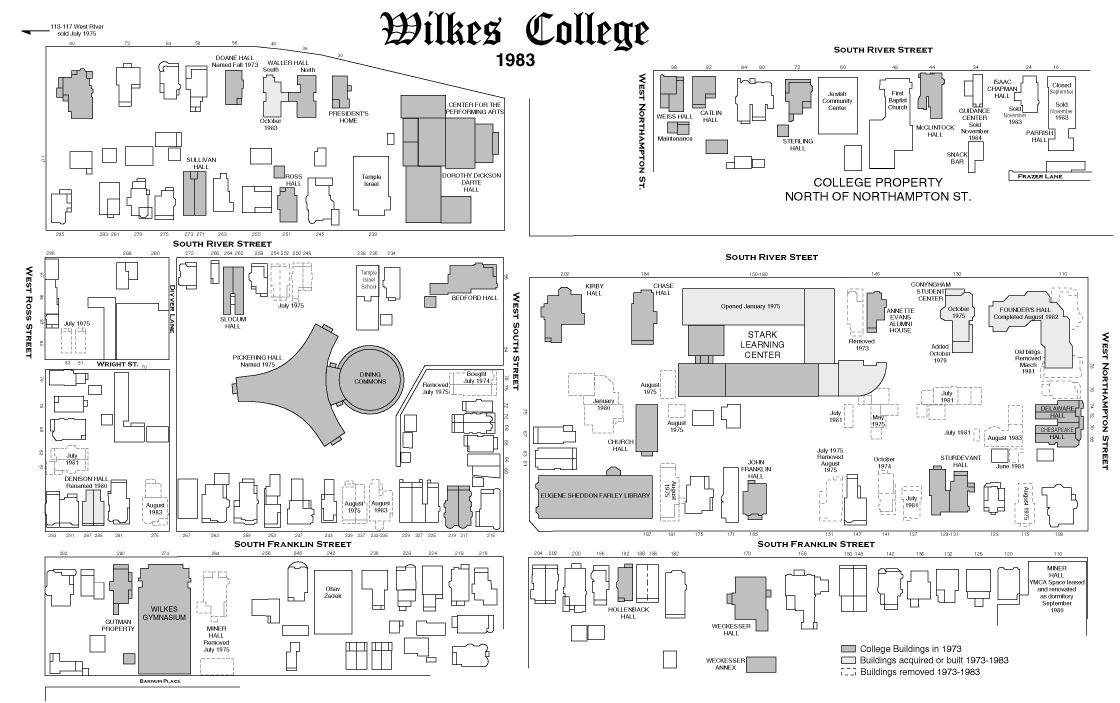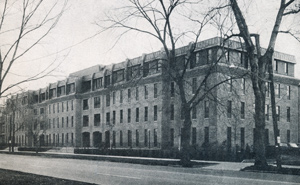
A number of fortuitous circumstances combined to make the decade before Hurricane Agnes external website one of optimism and explosive growth.
A series of misfortunes beginning with Agnes created a different environment. By itself, Agnes could not threaten Wilkes' future, but Agnes was not alone.
The end of the baby boom meant that the reservoir of applicants clamoring for admission shrank. The reservoir was further diminished by the rapid growth of the Luzerne County Community College, founded in the late 1960s to provide a less expensive alternative for the first two years of college. Wilkes had been established forty years previously to provide the same service and its competition with Kings' College had been on a level playing field. Now for the first time it was directly competing with a government-subsidized institution.
The economy provided additional difficulties. Flood and competition were followed by the energy crisis and declining federal support for higher education. As the decade progressed, inflationary pressures increased until prices rose at a rate greater than at any previous time in this century.

The full extent of the crisis did not become evident immediately. Wilkes received $13 million in federal funds to pay for post-flood reconstruction. Plans to complete Stark Hall with a new academic building fronting on South River Street had begun with demolition of five of the six buildings lying between Chase Hall and the Farley Home in mid-1971. The flood delayed completion but the Stark extension was finally opened in January 1975. In the interim, external space such as the Presbyterian Church House was once again used for classrooms.
As the problems of the seventies deepened, Wilkes moved from a period of expansion to one of consolidation. Only four buildings were acquired between 1973 and 1983, two for demolition to open up the campus. The southern half of Waller Hall was secured for a residence hall in October 1983. The home at 130 South River St., the last private home in the block, was secured from the Conyngham estate in October 1975. It was opened in October 1979 as the Conyngham Student Center, replacing the old College Commons which was demolished three months later.
The loss of some existing and potential residence halls to the flood and the need to reduce costs by consolidating housing facilities caused housing problems, resolved by the lease and renovation of the housing facilities in the Y. M. C. A., redesignated as the third Miner Hall and opened in September 1980. This allowed the College to abandon its long-term lease of facilities in the Sterling Hotel. In September 1982, William D. Evans Hall, a new co-ed residence hall, was opened at South River and Northampton streets.
Changing social and demographic conditions led to a change in the character of the campus. While use of existing buildings had allowed Wilkes to develop with minimal facilities investment, this type of campus brought many liabilities to a maturing college. With more than 60 occupied buildings at the peak, not counting the remaining outbuildings, the College incurred increasing maintenance expenses. Rising utility costs affected old buildings which lacked adequate insulation, as well as Pickering Hall, which used electric heat, and new Stark, which had been built with sealed windows and some windowless rooms in the best '70s style.
As Wilkes acquired more neighborhood houses, it increasingly secured less ornate buildings, in contrast to the earlier solid riverfront mansions. Many had been used as apartment houses with minimal maintenance prior to acquisition by the College. Some had faded with the declining fortunes of the anthracite aristocracy, the descendants of whom took flight to the suburbs. Buildings such as Kirby, Chase, Bedford, and the Annette Evans Alumni House, formerly the Farley residence, were renovated, but finances limited the extent to which this could be done.
The problem of preservation was complicated by Agnes. Buildings of marginal condition and utility prior to the flood, particularly in the block below South Street, were financially and practically unsalvageable and were removed. The decayed out-buildings remaining in the main campus block suffered a similar fate, as did some of the less distinguished buildings along Franklin Street. Possibly the most regrettable loss was Harding Hall. However, pictures of the time show that Harding had deteriorated significantly prior to purchase. It received its coup de grace from Agnes.
The removals caused considerable controversy among area preservationists, controversy which continues today as the campus continues to evolve. However, the efforts which have been made and which continue to be made, such as the imminent renovation of Capin Hall and the plans for new buildings which will be architecturally compatible with the historic character of the neighborhood, represent an attempt to preserve a sense of the past while creating a viable, functional neighborhood to contribute to Wilkes-Barre's present.
The restructuring of the campus also led to a retreat on its northern frontier. As the College had grown, its direction had been governed as much by targets of opportunity as by a coherent long-range acquisition plan. By the 1970s, it was clear that the College should concentrate its development between Northampton and Ross streets. Housing in the Sterling Hotel on Market Street was discontinued in 1981. In 1983 the entire north end of the campus, including Chapman and Parrish halls and the Guidance Center, was sold. By that time, Parrish had outlived its usefulness. A large building, its construction resisted easy renovation and it contained much unusable space. It became the headquarters of the Guard Insurance Group.